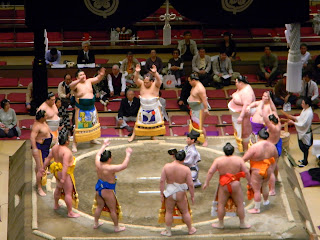Quite frankly, I've been putting off this blog post for some time now. My reluctantance to tackle this topic was because I wasn't sure how to describe it without sounding like a pompous jerk or a kindergarten teacher. I suppose I should just bite the bullet and start with a little background.
Here is the funny thing, I first applied at AIST to do research on dye-sensitized photo cells. I submitted the application knowing that I was unqualified to handle the hazardous chemicals associated with it. Seeing that both Matt and I were passionate and motivated, they allowed us to come work in the Turbomachinery Division to do research in Dielectric Barrier Discharge Plasma Actuators (DBDPA) and the Properties of Hydrogen Combustion. Whew, what a mouth full. After getting settled in, we had a meeting with our bosses and decided that I would be working on Plasma Actuators while Matt handled Hydrogen Combustion. One thing that is really nice is that Matt and I are still given the freedom to help each other out on either project.
Okie dokie, its about to get a lot nerdier in here as I explain plasma actuators. If you don't much care about how it works simply skip over the first two bold sections and we can meet again later down the page at Finally...what I actually do! For everyone else, put on your favorite galoshes and take my hand as we try to wade through this sticky, smelly, swamp of science.
What is a Single Dielectric Barrier Discharge Plasma Actuator (DBDPA)?
The DBDPA I work with is composed to two electrodes (just think of wires) separated by a thin layer of dielectric material. The top electrode is exposed to the air whereas the bottom electrode is often submerged in dielectric material. When low current/high AC voltage is supplied, air close to the exposed electrode becomes weakly ionized. This ionized air is called plasma. The plasma creates what is called a body force vector field. It's this body force which is used to control flow. Below is a diagram that should help.
What's the point?
Most people know what happens when an airplane tries to climb altitude too fast, it stalls and loses lift. This is due to a little thing we call flow separation which can cause major problems for airplanes and (wait for it...) wind turbines! Modern wind turbines rely on principals of lift and drag. So, when flow separation occurs, efficiency goes down. If flow separation can be prevented, airplanes can fly at a higher angle of attack and wind turbines can capture more energy. Below are some images of plasma actuators preventing flow separation on airfoils.
Finally....what I actually do!
The first major task I've been assigned involves redesigning almost all aspects of the DBDPA experiment. I designed the Plexiglas wind tunnel test section, the electrode arrangement, and the airfoil itself. Once everything is put together we will do tests in an attempt to optimize about a dozen things including input voltage, electrode configuration, and overall performance. Depending on when I'm able to get all of this nailed down, I might be able to write up a technical paper and present it at the "International Symposium on Low Carbon & Renewable Energy Technology" in South Korea in November. Visiting South Korea would be awesome so I'm really going to push to get a paper submitted
If all goes well, I will start working on a 2nd phase of the project which involves making a 'smart wing.' Basically we want to try to design a wing that can turn on/off the plasma actuators when it senses that it has flow separation. Making a 'smart wing' is a daunting task, but I'm excited to try.
BONUS: Plasma Actuator Air Jets?!
That's right, people have arranged the electrodes to produce little air jets. Who knows, maybe someday they will make a hover craft with using this technology. Below is a pic of one of these.
Ahhhhhhhhh, see? We made it through. Hopefully I didn't come across as a 'know-it-all' and I hope you find this stuff as interesting as I do. Please let me know if you have any questions about any of this. I'd be more than willing to answer anything. Whelp, I'm going to go rest my brain for a while.
-Seth
Here is the funny thing, I first applied at AIST to do research on dye-sensitized photo cells. I submitted the application knowing that I was unqualified to handle the hazardous chemicals associated with it. Seeing that both Matt and I were passionate and motivated, they allowed us to come work in the Turbomachinery Division to do research in Dielectric Barrier Discharge Plasma Actuators (DBDPA) and the Properties of Hydrogen Combustion. Whew, what a mouth full. After getting settled in, we had a meeting with our bosses and decided that I would be working on Plasma Actuators while Matt handled Hydrogen Combustion. One thing that is really nice is that Matt and I are still given the freedom to help each other out on either project.
Okie dokie, its about to get a lot nerdier in here as I explain plasma actuators. If you don't much care about how it works simply skip over the first two bold sections and we can meet again later down the page at Finally...what I actually do! For everyone else, put on your favorite galoshes and take my hand as we try to wade through this sticky, smelly, swamp of science.
What is a Single Dielectric Barrier Discharge Plasma Actuator (DBDPA)?
The DBDPA I work with is composed to two electrodes (just think of wires) separated by a thin layer of dielectric material. The top electrode is exposed to the air whereas the bottom electrode is often submerged in dielectric material. When low current/high AC voltage is supplied, air close to the exposed electrode becomes weakly ionized. This ionized air is called plasma. The plasma creates what is called a body force vector field. It's this body force which is used to control flow. Below is a diagram that should help.
Plasma Actuator configuration. (University of Kentucky)
What's the point?
Most people know what happens when an airplane tries to climb altitude too fast, it stalls and loses lift. This is due to a little thing we call flow separation which can cause major problems for airplanes and (wait for it...) wind turbines! Modern wind turbines rely on principals of lift and drag. So, when flow separation occurs, efficiency goes down. If flow separation can be prevented, airplanes can fly at a higher angle of attack and wind turbines can capture more energy. Below are some images of plasma actuators preventing flow separation on airfoils.
With the plasma actuator on, the flow reattaches. (University of Tennessee, NASA)
Finally....what I actually do!
The first major task I've been assigned involves redesigning almost all aspects of the DBDPA experiment. I designed the Plexiglas wind tunnel test section, the electrode arrangement, and the airfoil itself. Once everything is put together we will do tests in an attempt to optimize about a dozen things including input voltage, electrode configuration, and overall performance. Depending on when I'm able to get all of this nailed down, I might be able to write up a technical paper and present it at the "International Symposium on Low Carbon & Renewable Energy Technology" in South Korea in November. Visiting South Korea would be awesome so I'm really going to push to get a paper submitted
If all goes well, I will start working on a 2nd phase of the project which involves making a 'smart wing.' Basically we want to try to design a wing that can turn on/off the plasma actuators when it senses that it has flow separation. Making a 'smart wing' is a daunting task, but I'm excited to try.
BONUS: Plasma Actuator Air Jets?!
That's right, people have arranged the electrodes to produce little air jets. Who knows, maybe someday they will make a hover craft with using this technology. Below is a pic of one of these.
DBDPA Air Jet
-Seth




















































